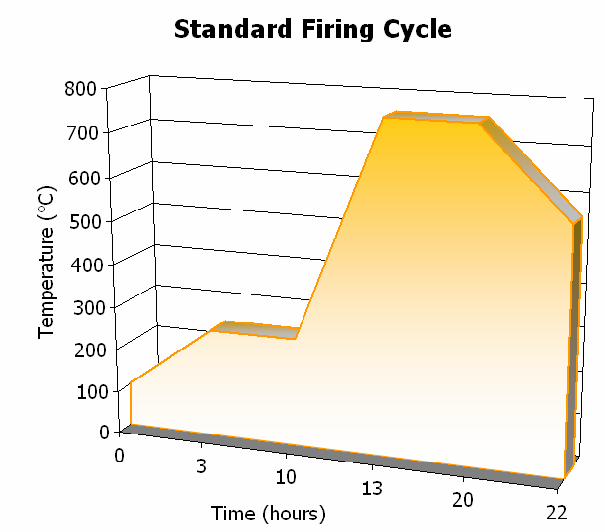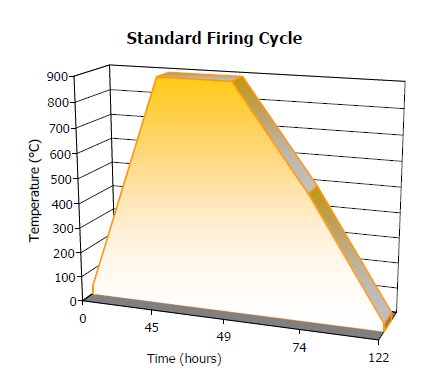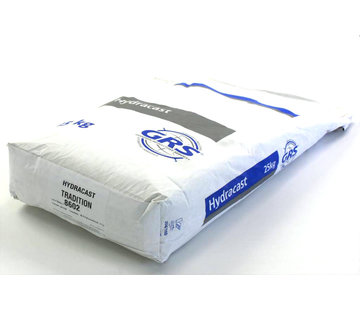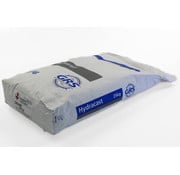HYDRACAST ™ Cre'Art - 25 kg.
A ready to use, plaster-based, fine grained refractory investment, specially formulated for use in artistic applications.
This product was developed to produce large (20 cm to 1 m) ornamental parts from copper alloys as well as detailed and complex Pâte de verre pieces.
Its characteristics make it the preferred plaster for a large number of art foundries
- Professional results
- Simple processing
- Ideal for lost wax
- Ideal for glass art
- Suited for aluminium up to bronze castings
Technical data
- % of water used: 36% (saturation mix)
- Mixing time: 4 minutes
- Working / Casting time: 14 minutes
- Setting time: 20-24 minutes
- Liquid density: 1.8 g/cm³
- Weight per liter of slip: 1800 gram (1325 g. powder / 475 g. water)
- Expension 1 hour after setting time: 0.30%
Procedure for the Lost Wax process
The recommended plaster to water ratio is 100 parts of plaster for 36 parts of water. This ratio can be changed to precisely fit your application
a) Mixing Mixing plaster in water is the most important step in making a mould and could heavily impact resistance, hardness and absorption properties if performed incorrectly. For optimum quality, vacuum mixing is recommended.
Always ensure the following points:
1. Plaster and water are precisely weighed.
2. All equipment is clean.
3. The mixing cycle is adhered to.
b) Casting Pour the mix immediately after finishing mixing. Make sure that the mixture does not become too thick or too hard. Always pour the mixture so that it slowly covers the surface of the part to be reproduced, without trapping or creating air bubbles. Vacuum casting avoids forming air bubbles
c) Plaster setting Do not handle plaster containing wax model until it has reached its setting time to avoid any defects in the finished part. Wait at least a minimum of 2 hours before starting the drying cycle.
d) Dewaxing / firing All water must be removed before pouring metal to obtain proper mechanical resistance and limit defects. Note: drying time is heavily dependent on the size and number of cylinders in the oven.
Dewaxing is performed under moist conditions between 100/100°C, or dry conditions between 150/160°C, for 6 to 8 hours. Dewaxing at temperatures higher than 400°C produces a perfect interior surface by eliminating the last traces of wax.
 Standard firing cycle for art foundry:
Standard firing cycle for art foundry:
- increase to 250°C (100°C/hr) and maintain for 6 to 8 hours.
- increase temperature to 760°C (150°C/hr)
- maintain at 760°C for 6 to 8 hours
- cool down at a rate of 100°C and maintain at the desired temperature  Standard firing cycle for Pâte de verre:
Standard firing cycle for Pâte de verre:
- Fill the cavity and refractory pot (potentially made of Hydracast) placed on top of the mould with pieces of crystal increase to 850/900°C at a rate of 15/20°C/hr
- maintain at 850/900°C for 4 hours
- reduce from 850/900°C to 500°C at a rate of 20°C/hr
- temperature can be maintained at 500°C for several hours to heat soak the mould
- reduce from 500°C to 20°C at a rate of 10°C/hr
e) Knocking-out The mould is left to cool down, then shattered by immersion in water and/or by using a high pressure cleaning system. The part can then be recovered to undergo finishing steps.
Shelf Life
Do not expose to freezing and moisture, 12 months under dry condition pictures
Health and Safety
HYDRACAST™ CreArt may generate dust. We therefore recommend that a mask be always worn whilst working with this refractory product and to ensure that the workplace is well ventilated.

Health Warnings / H Phrases
H332 Harmful by inhalation.
H334 May cause allergy or asthma symptoms or breathing difficulties if inhaled.

Precautions / P phrases
P261 Avoid breathing dust/fume/gas/mist/vapours/spray.
Product Information
 Product information sheet Hydracast CreArt
Product information sheet Hydracast CreArt
 EN - Health and Safety Guidance For Using Silica Based Products.pdf
EN - Health and Safety Guidance For Using Silica Based Products.pdf








